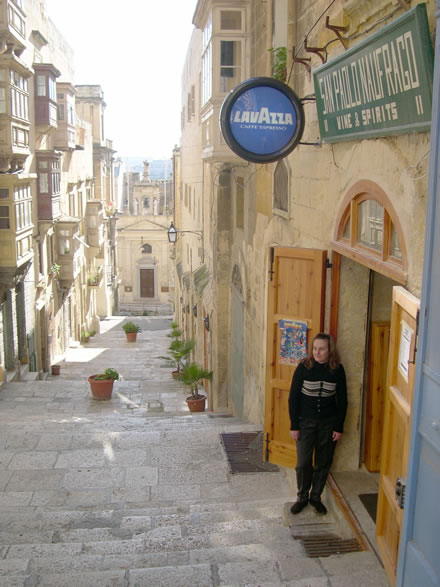Malta Off Season
Take a Trip Through History
Story and Photos By Barbara Bode

Malta is a magical time machine where you are enveloped by history. For curious and adventuresome independent travelers, the island is a perfect off-season destination: affordable, infinitely interesting, safe, friendly,
English-speaking….I spent a month there in January 2003 and was so entranced that I decided to move there.
More than a Mediterranean resort, Malta is a place of burial vaults built before the Pyramids, temples that pre-date Stonehenge, and caves from the Punic Wars. A dozen UNESCO Heritage sites dot the islands. You can
see catacombs and viaducts erected by the Romans, villages established by Arabs, and the historic evidence from victorious battles against the Turks in 1565 and against the Axis powers in 1940. And then enjoy evenings out at the theater,
opera, dinner, and the casino.
The off-season begins September 16 and lasts through May, but the best deals are to be found from November 1 through March 31. With the exception of a rise in prices for three weeks around Christmas, off-season means
much lower hotel rates and much lower travel costs. My first week there I luxuriated in the 5-star Corinthia Hotel on St. George's Bay for $50 a night with a full buffet breakfast included. During July and August the rate for that same
room is $255.
Generally overlooked when you travel off-season is the added benefit of much greater personal attention from shopkeepers and onsite tour guides as well as from residents. Lonely museum curators are eager to enlighten
visitors. Strange as it might seem in a country where most speak English, Americans are rarely sighted except in an occasional tour group.
Perhaps the Maltese became hospitable as a way of self-preservation. The islands have always been a way station for Mediterranean sailors: Phoenicians, Carthaginians, and crusaders. The abrupt appearance of the Normans
ended a thousand years of Arab rule. Thereafter, various princes of the Holy Roman Empire denied Malta's hopes for sovereignty.
Renaissance Valletta
Valletta, the "new" capital of Malta, transports you back to the late 16th century. Thanks to the Pope who sent his Michelangelo-trained architect there, the new city was carefully designed and fortified.
It even had its own mandatory municipal water and sewage system.
To put your explorations of Malta in context, go down innumerable stone stairs into the basement of the Sacra Infermeria, the Malta Knights’ old hospital, built in 1568. A theater there shows "The Malta Experience," a
splendid overview of Maltese history.
Steps in Valletta are unavoidable. The steepest hills have broad steps that are only two to three inches high. Why? The knights, in their heavy armor, couldn't bend their knees easily so they had to fling out their
legs from side to side to navigate the hills.
Consider making Valletta your home base. The four city hotels are well located and affordably priced. The Castille Hotel, where I stayed on and off for three weeks, and The Osborne Hotel (both three stars) are at the
western end of Valletta near the city gate. On the south side are The British Hotel and the Grand Harbor Hotel (both two stars). At The Castille, I paid $30 a night including breakfast in the rooftop restaurant overlooking the Grand Harbor.
Valletta works as your central location because the bus terminal — not a building but a big parking lot — is just outside the city gates, and harbor cruises depart daily for various tours and destinations. Inside
the city walls are galleries, museums, cathedrals, theaters, opera, concerts, first-run movies, and 5-star dining — all in easy walking distance. Valletta, like the rest of Malta, is relatively crime-free.
Take a Big Yellow Bus
From Valletta, bus routes go everywhere. Drivers and passengers are helpfully chatty. The big old yellow British buses from the 1950s are cheap — less than a dollar takes you all over the island. If you want to
go somewhere by car, hire an inexpensive car and driver service.
In 2000, UNESCO declared Valletta a World Heritage site: "The capital of Malta is inextricably linked to the history of the military and charitable Order of St John of Jerusalem. It was ruled successively by the
Phoenicians, Greeks, Carthaginians, Romans, Byzantines, Arabs and the Order of the Knights of St John. Its 320 monuments, all within an area of approximately 22 acres, make it one of the most concentrated historic areas in the world."
There is no better introduction to the socio-history of medieval Malta than a tour of the Casa Rocca Piccola, a 16th Century palazzo in Republic Street — the home of a Maltese noble family led today by the witty,
urbane, and self-deprecating Marquis Nicholas de Piro. He, like some of the British nobility, maintains the mansion with the fees from his tours of the main rooms.
Among the many fascinating sites to visit within easy reach of Valletta is Ggantija. Take a half-hour ferry ride to Gozo, Malta's sister island, to explore this pair of goddess temples built c. 5100-3500 BC. They are
the oldest surviving structures in the world. While there, you can also check out Calypso's cave and the fascinating museums inside the cathedral walls of Victoria, Gozo's capital city.
A Recreational Resort
Malta is, after all, a resort destination. I traveled there because of my interest in history but there are many more active adventures to be enjoyed: spectacular diving, sailing, and swimming, and of course horse
trails and bicycle paths. Sophisticated and fashionable towns stretch northward up the east coast from Valletta. Fashionable boutiques, shopping malls, fine restaurants, and colorful casinos allow you to help the local economy. All are
bordered by the deep blue Mediterranean and the colorful luzzus, the Maltese fishing boats. Malta takes you on a trip through time.
BARBARA BODE spent a tenure as president of the Children’s Foundation in Washington, DC. She now lives and writes on Gozo, Malta’s sister island.
|
